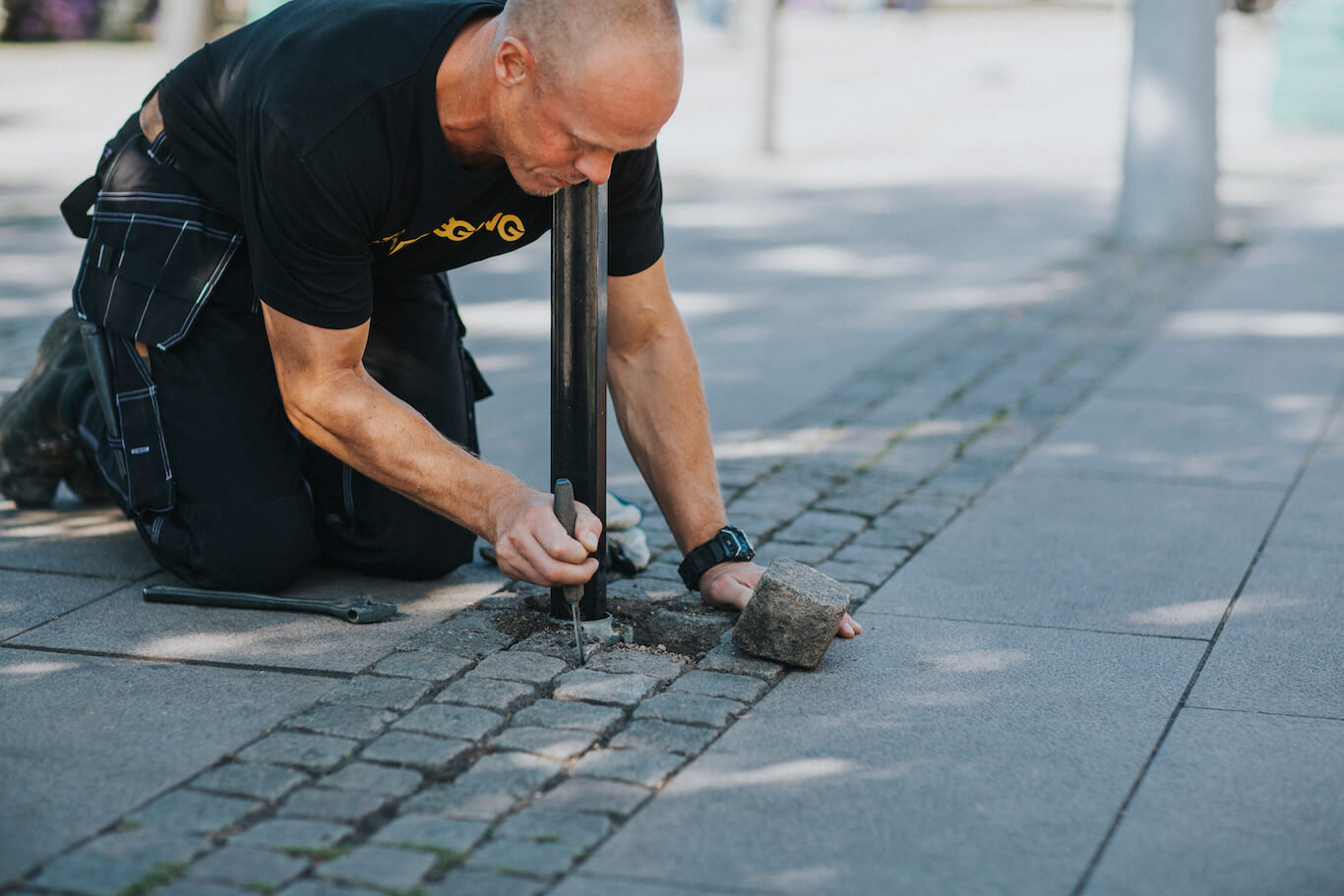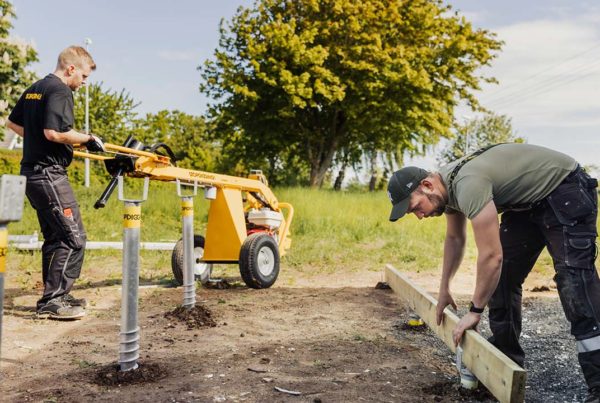GROUND SCREW IS A BETTER ALTERNATIVE TO CONCRETE DEMANDS
Although there are different types of concrete plinths, for example concrete plinths with feet or concrete plinths with base plate, it is not always the best option. Of course, it is a good grounding if the ground work is done properly, but the problem is that it often takes a long time to do all the preparatory work with excavation, casting and soldering. If you instead want a good anchorage, which requires minimal work on your part, you should consider ground screw. We at Sluta Gräv have several types of ground screws to suit many types of constructions.
When you choose to buy our ground screws, book an appointment with one of our fitters who will come and assemble them for you. They can be mounted all year round, even when it is frosty and works with most substrates. The holes are pre-drilled before the screw is mounted so that it leaves as few grooves as possible in the event of removal. In addition, the ground screw can be reused if you move or need to change places on, for example, your storage.
Our ground screws are made of hot-dip galvanized steel and thus can withstand harsh climates without any risk of rust. They are both CE marked and ISO certified at the same time as their dimensions follow the Swedish construction standard. All types of ground screw you can choose from us are tested for both tensile and load. They also have many uses for special assembly in case you need it.
A ground screw is simpler and more cost-effective than a concrete plinth, at the same time as it is more environmentally friendly. A ground screw emits 60% less carbon dioxide than the concrete plinth. Stop Gräv’s ground screw works just as well as a concrete plinth, but the benefits of it are far more, you can also start building immediately after the installation is completed.
CONCRETE PLINTS
In Sweden, it is common with concrete plinths as a building foundation. It is relatively easy to cast your own concrete plinth, but nowadays it does not differ much in price from buying finished ones. However, it always means working time and money to dig to lay a foundation with plinths, how much depends on what the ground looks like.
It is important that the concrete plinth reaches a load-bearing surface regardless of which ground you are to build on. If the soil consists of stone and gravel, a depth of 50 to 70 centimeters is required, which is a common measure of finished plinths. In cases where the soil is porous and rich in mulch, a deeper hole is needed for the plinth to be stable, then it is also best to cast your concrete plinths in place so that they can be customized. In order for the concrete plinths to last a long time, it is important that they reach frost-free depth.
Once you have measured the size of your planned construction, dig holes for the plinths, put some gravel at the bottom, lower the plinths and then fill with soil mass. The distance between the terminals should never exceed two meters as this can then affect the bearing capacity of the structure. The upper edge of the terminals must be at the same height, so it is advisable to use a spirit level or laser to check that they are level.
Self-cast concrete plinths are adjustable until they have dried, which makes it easier to get them level. To cast your own plinths, you must first dig holes that are 50 cm deep with a diameter of 50 cm. If the ground is loose, a diameter of around two meters may be necessary instead. After you have finished digging, you should bottom with 10 cm of gravel and then fill in with another 10 cm of ground insulation. Then place a casting pipe in the pit, solder it straight and fill it with soil to fix it. Only when all this has been done should the concrete be mixed and then poured into the pipe. With a board that you move up and down in the concrete, you can remove the air bubbles that form. Then the post shoes or plinth irons are placed in the middle of the concrete, a board is placed across the hole so that they do not sink down and then the concrete needs to burn, ie solidify, for 24 hours.
THINGS YOU CAN BUILD WITH CONCRETE DEMANDS AS A BASIS
Concrete plinths are suitable for many types of construction, depending on whether you choose finished plinths or to cast your own. You can, for example, have a plinth foundation for your house, but then it is important that you do a ground survey if you are the least unsure of the ground your house should stand on. Namely, there is a slightly greater risk of subsidence when you use concrete plinths, at least if you are careless with the ground work. Therefore, be very careful with the excavation and preparation if you choose to use a plinth foundation.
You can also use plinths when you are building holiday homes or attefallshus. Even then, you should think about what land you are going to build on. When building on rock, there is no risk of subsidence, but it is a costly task to prepare a bedrock. If your house is built with a plinth foundation, you should also use it for your terrace or extension, but it is not a must.
It is also easy to use concrete plinths for fences. Then they should stand at intervals of about two meters and even then it is important that you make sure that they are level. In other words, it takes some bringing work for the end result to be good.
ADVANTAGES AND DISADVANTAGES OF THE USE OF CONCRETE DEMANDS
An advantage of a concrete plinth is its relatively low price, at least in comparison with a cast foundation, regardless of whether you cast the plinth yourself or buy ready-made. The disadvantage of concrete plinths, however, is that it requires a lot of work, both when it comes to ground work and because they are heavy to carry. It can also be difficult to get them horizontal and there is a risk that they will sit down.
A major disadvantage once the plinth is lowered is that it sits where it sits, a cast concrete plinth is adjustable with the post shoe or the plinth iron until it has dried. When you choose to build with concrete plinths as ground anchoring, you must plan your construction before there is frost in the ground, which means that it is not an option to use during the winter. In addition, it is difficult to dig in a certain type of ground surface.





